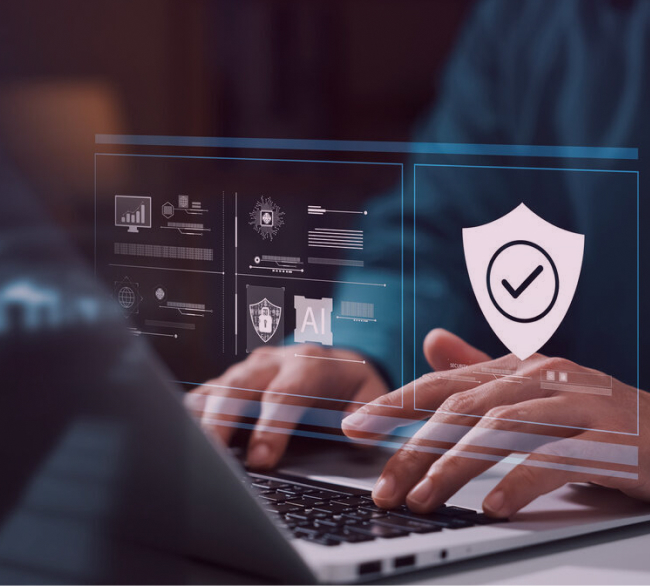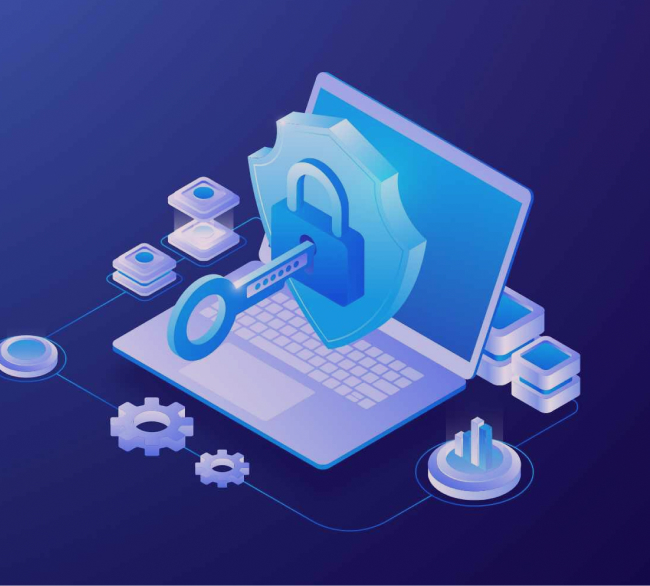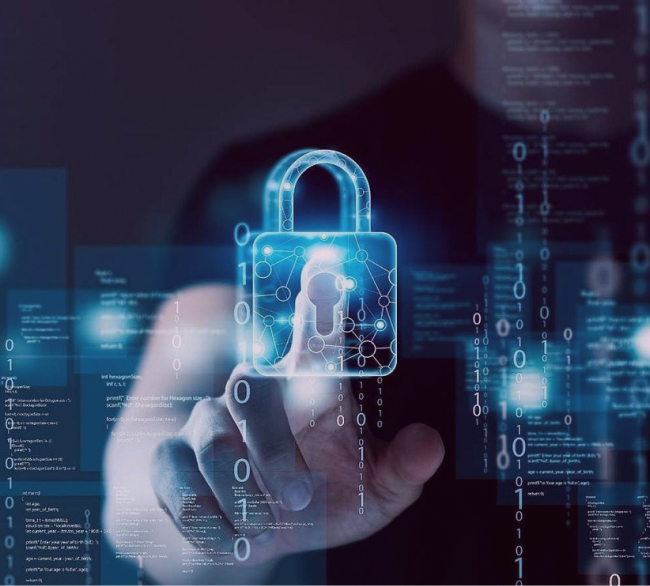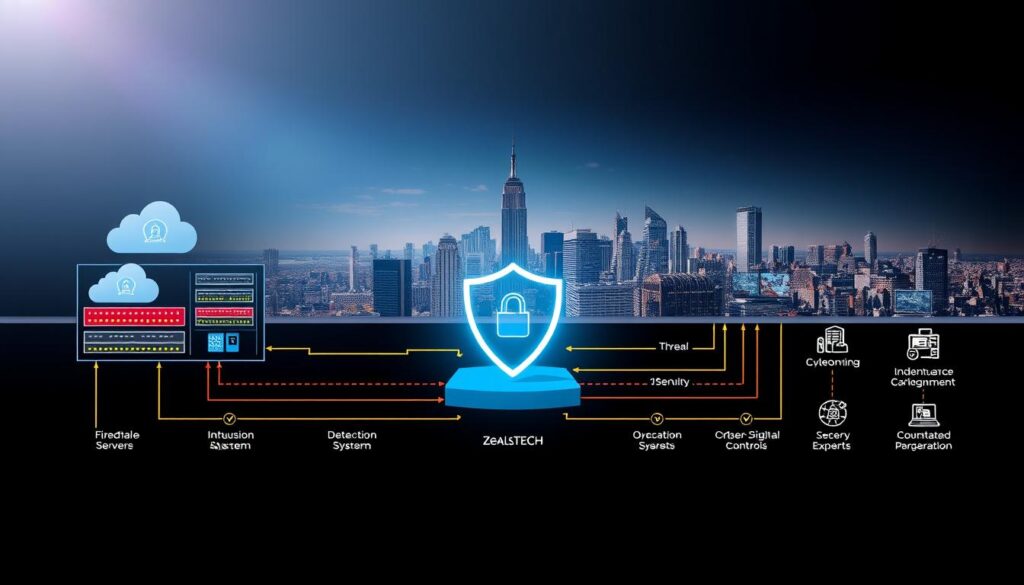In today’s digital landscape, businesses face an ever-evolving array of cyber threats. Cybersecurity Solutions are no longer a luxury, but a necessity.
Managed IT Security provides a comprehensive approach to protecting businesses from these threats. It involves outsourcing IT security needs to a team of experts who monitor, manage, and maintain the security infrastructure.
This proactive approach ensures that businesses are always one step ahead of potential threats, safeguarding their sensitive data and maintaining operational continuity.
Key Takeaways
- Understanding the concept of Managed IT Security
- Recognizing the importance of Cybersecurity Solutions
- Outsourcing IT security for enhanced protection
- Proactive threat management and mitigation
- Maintaining business continuity through robust security measures
Understanding Managed Security Services

With the rise of sophisticated cyber threats, managed security services have emerged as a vital component of IT security management. As organizations strive to protect their digital assets, the demand for comprehensive cybersecurity solutions has never been higher.
Definition and Core Concepts
Managed security services refer to the practice of outsourcing security functions to a third-party provider. This approach allows organizations to leverage the expertise and resources of the service provider to enhance their cybersecurity posture.
The core concepts of managed security services include:
- Proactive Threat Detection: Identifying potential threats before they cause harm.
- Incident Response: Responding effectively to security incidents to minimize damage.
- Vulnerability Management: Regularly assessing and mitigating vulnerabilities in systems and networks.
- Compliance Management: Ensuring that security practices comply with relevant regulations and standards.
Evolution of Managed Security
The evolution of managed security services has been driven by the growing complexity of cybersecurity threats and the need for specialized expertise. Initially, managed security services focused on basic monitoring and incident response. However, over time, they have expanded to include advanced services such as:
- Threat intelligence and analysis
- Advanced threat detection and response
- Security information and event management (SIEM)
- Cloud security services
Today, managed security services play a critical role in helping organizations stay ahead of emerging threats and maintain a robust cybersecurity posture.
The Growing Need for Managed IT Security
In today’s digital landscape, the growing need for managed IT security is driven by the escalating sophistication of cyber threats. As technology advances, cybercriminals are becoming more adept at exploiting vulnerabilities, making it imperative for organizations to bolster their defenses.
Current Cybersecurity Threat Landscape
The current cybersecurity threat landscape is complex and ever-evolving. Cyber threats range from simple malware infections to sophisticated, targeted attacks designed to bypass traditional security measures.
Common Attack Vectors
Cyber attackers often exploit common vulnerabilities to gain unauthorized access to systems. Some of the most prevalent attack vectors include:
- Phishing and social engineering tactics
- Exploiting unpatched software vulnerabilities
- Using weak or default passwords
- Malware and ransomware attacks
Emerging Threats
As technology evolves, new threats emerge. Some of the emerging threats in the cybersecurity landscape include:
- Advanced Persistent Threats (APTs)
- Zero-day exploits
- Artificial intelligence-powered attacks
- Internet of Things (IoT) vulnerabilities
Challenges Faced by In-House Security Teams
In-house security teams face numerous challenges in protecting their organization’s digital assets. Some of these challenges include:
- Limited resources and budget constraints
- The ever-evolving nature of cyber threats
- Attracting and retaining skilled cybersecurity professionals
- Staying up-to-date with the latest security technologies and best practices
Regulatory Compliance Requirements
| Regulation | Description | Industry |
| GDPR | General Data Protection Regulation | All industries operating in the EU |
| HIPAA | Health Insurance Portability and Accountability Act | Healthcare |
| PCI-DSS | Payment Card Industry Data Security Standard | Financial Services |
Organizations must comply with various regulatory requirements related to data security and privacy. Some of the key regulations include:Non-compliance with these regulations can result in significant fines and reputational damage. Managed IT security services can help organizations navigate the complex regulatory landscape and ensure compliance.
Key Components of Managed Security

The backbone of managed security services includes a range of critical components designed to safeguard against evolving cyber threats. These components work in tandem to provide comprehensive security coverage, ensuring that an organization’s digital assets are protected around the clock.
24/7 Security Monitoring and Response
Continuous monitoring is a crucial aspect of managed security, involving the constant surveillance of an organization’s IT infrastructure to detect and respond to security incidents in real-time. This 24/7 monitoring capability ensures that potential threats are identified and mitigated before they can cause significant harm.
Vulnerability Management
Vulnerability management is another key component, focusing on identifying, classifying, and remediating vulnerabilities in systems and applications. This process involves regular vulnerability assessments and penetration testing to uncover weaknesses that could be exploited by attackers.
- Identifying vulnerabilities through automated scans and manual testing
- Prioritizing vulnerabilities based on risk and potential impact
- Applying patches and fixes to remediate identified vulnerabilities
Threat Intelligence and Analysis
Managed security providers also offer threat intelligence services, which involve gathering and analyzing data on emerging threats to provide actionable insights. This intelligence helps organizations stay ahead of potential threats by understanding the tactics, techniques, and procedures (TTPs) used by attackers.
Security Incident Response
In the event of a security incident, having a well-planned incident response strategy is critical. Managed security services include incident response planning, ensuring that organizations are prepared to respond effectively to security breaches, minimizing downtime and data loss.
Compliance Management
Finally, compliance management is a vital component, as it ensures that an organization’s security practices align with relevant regulatory requirements and industry standards. This includes regular audits, compliance monitoring, and guidance on maintaining compliance.
Types of Managed Security Services

The landscape of Managed Security Services is diverse, offering a range of solutions tailored to different organizational requirements. As cybersecurity threats continue to evolve, organizations can benefit from a variety of managed security services designed to protect their digital assets.
Managed Firewall Services
Managed Firewall Services provide a crucial layer of security by controlling incoming and outgoing network traffic based on predetermined security rules. These services are essential for preventing unauthorized access to an organization’s network.
Managed Detection and Response (MDR)
MDR services offer advanced threat detection and incident response capabilities. By leveraging MDR, organizations can quickly identify and respond to security incidents, minimizing potential damage.
Security Information and Event Management (SIEM)
SIEM solutions provide real-time monitoring and analysis of security-related data from various sources. This helps in identifying potential security threats and compliance issues.
| Service Type | Description | Key Benefits |
| Managed Firewall Services | Control of incoming and outgoing network traffic | Prevents unauthorized network access |
| Managed Detection and Response (MDR) | Advanced threat detection and incident response | Quick identification and response to security incidents |
| Security Information and Event Management (SIEM) | Real-time monitoring and analysis of security data | Identifies potential security threats and compliance issues |
| Endpoint Protection Services | Protection of endpoint devices from cyber threats | Prevents malware and other endpoint threats |
| Cloud Security Services | Security solutions for cloud environments | Protects cloud infrastructure and data |
Endpoint Protection Services
Endpoint Protection Services are designed to protect endpoint devices such as laptops, desktops, and mobile devices from cyber threats. These services typically include antivirus software, intrusion detection, and other security measures.
Cloud Security Services
Cloud Security Services provide organizations with the necessary tools and expertise to secure their cloud environments. This includes data encryption, access controls, and monitoring of cloud infrastructure.
Benefits of Outsourcing IT Security

In today’s complex cybersecurity landscape, outsourcing IT security offers numerous benefits to organizations.
Access to Specialized Expertise
One of the primary advantages of outsourcing IT security is gaining access to cybersecurity expertise that may not be available in-house.
Security Certifications and Training
Managed security service providers employ professionals with advanced security certifications and continuous training, ensuring they stay updated on the latest threats and mitigation strategies.
Diverse Experience Across Industries
These experts bring experience from various industries, allowing them to apply best practices and lessons learned to your organization’s security framework.
Cost Efficiency and Predictable Budgeting
Outsourcing IT security can lead to significant cost efficiency, as it eliminates the need for substantial upfront investments in security infrastructure and personnel.
- Reduces capital expenditures on hardware and software.
- Converts security costs into predictable operational expenses.
- Minimizes the costs associated with training and maintaining an in-house security team.
Scalability and Flexibility
Managed security services offer the scalability and flexibility needed to adapt to changing security demands.
Whether your organization is growing, downsizing, or experiencing fluctuating security needs, outsourced IT security can adjust accordingly.
Improved Security Posture
By leveraging the expertise and resources of a managed security service provider, organizations can significantly improve their security posture.
“Outsourcing IT security allows companies to benefit from advanced security measures and expert knowledge, enhancing their overall security stance.”
Focus on Core Business Functions
Outsourcing IT security enables businesses to focus on their core functions, leaving the complexities of cybersecurity to the experts.
- Allows internal teams to concentrate on strategic business initiatives.
- Reduces the burden on internal IT staff, improving overall IT efficiency.
Managed Security for Different Business Sizes
The landscape of managed security varies significantly across different business sizes, from small businesses to large enterprises. Each category has its unique security needs and challenges, requiring tailored approaches to effectively manage and mitigate risks.
Solutions for Small Businesses
Small businesses often have limited resources and less complex IT infrastructures, but they are not immune to cyber threats. Managed security services for small businesses typically focus on foundational security measures such as:
- Basic firewall protection
- Antivirus software
- Email security
- Regular security awareness training
These services are designed to be cost-effective and easy to implement, providing a robust security posture without requiring significant in-house expertise.
Mid-Market Company Approaches
Mid-market companies have more complex IT environments and a broader range of security needs compared to small businesses. Their managed security services often include:
- Advanced threat detection and response
- Security Information and Event Management (SIEM) systems
- Compliance management for relevant regulations
- Enhanced endpoint protection
These services help mid-market companies to protect their growing digital assets and maintain regulatory compliance.
Enterprise-Level Security Management
Large enterprises face the most complex security challenges due to their extensive IT infrastructures, diverse user bases, and the high value of their data. Enterprise-level managed security involves comprehensive, multi-layered security strategies, including:
- Advanced threat intelligence
- Customized security architectures
- 24/7 security monitoring and incident response
- Continuous vulnerability management
Enterprises also benefit from managed security services that integrate with their existing security operations centers (SOCs) and other IT systems.
In conclusion, managed security services are not a one-size-fits-all solution. Providers must tailor their offerings to meet the specific needs of small businesses, mid-market companies, and large enterprises, ensuring that each receives the appropriate level of protection and support.
Industry-Specific Managed Security Considerations
Industry-specific managed security considerations are crucial for protecting sensitive data and ensuring compliance with regulatory requirements. Different sectors face unique cybersecurity challenges that necessitate tailored security measures.
Healthcare Security Requirements
The healthcare industry handles highly sensitive patient data, making it a prime target for cyberattacks. Managed security services for healthcare must ensure the confidentiality, integrity, and availability of protected health information (PHI).
- Compliance with HIPAA regulations
- Protection against ransomware attacks
- Secure electronic health records (EHRs)
Financial Services Protection
Financial institutions are subject to stringent security requirements to protect customer financial data and prevent fraud. Managed security services for financial services include:
- Advanced threat detection and response
- Compliance with PCI-DSS and other financial regulations
- Real-time monitoring of financial transactions
Retail and E-commerce Security
Retail and e-commerce businesses face unique security challenges, particularly with the rise of online shopping. Managed security for retail focuses on:
- Protecting customer payment information
- Preventing data breaches during peak shopping seasons
- Ensuring compliance with PCI-DSS
Manufacturing and Critical Infrastructure
Manufacturing and critical infrastructure sectors are increasingly reliant on connected systems, making them vulnerable to cyber threats. Managed security services for these industries involve:
- Safeguarding industrial control systems (ICS)
- Protecting against supply chain disruptions
- Ensuring the security of IoT devices
By understanding the specific security needs of different industries, organizations can better protect themselves against evolving cyber threats.
How to Choose the Right Managed Security Provider
Selecting the right managed security provider is a critical decision that can significantly impact your organization’s cybersecurity posture. With the increasing complexity of cyber threats, it’s essential to evaluate potential providers based on several key factors.
Essential Qualifications and Certifications
When evaluating managed security providers, look for industry-recognized certifications such as SOC 2, ISO 27001, or PCI-DSS. These certifications indicate that the provider has met rigorous standards for security and data protection. Additionally, consider their experience in handling security incidents and their expertise in your specific industry.
A reputable provider should have a team of certified security professionals, such as CISSP or CISM, who can effectively manage and respond to security threats. Their qualifications and certifications are a testament to their capability in providing top-notch security services.
Service Level Agreements (SLAs)
A well-defined Service Level Agreement (SLA) is crucial when selecting a managed security provider. The SLA should clearly outline the scope of services, response times, and resolution expectations. Ensure that the SLA includes provisions for incident response, vulnerability management, and compliance reporting.
It’s also important to understand the provider’s communication protocols and how they will keep you informed about security incidents or breaches. Regular updates and transparent communication are vital for maintaining a strong partnership.
Integration Capabilities
The ability of a managed security provider to integrate with your existing infrastructure is critical. They should be able to seamlessly integrate with your current security tools and systems, ensuring comprehensive protection without disrupting your operations.
Consider providers that offer flexible integration options, including APIs, SIEM systems, and other security technologies. This flexibility ensures that the provider can adapt to your evolving security needs.
Scalability Options
As your organization grows, your security needs will evolve. Therefore, it’s essential to choose a managed security provider that can scale their services to meet your changing requirements. Look for providers that offer flexible pricing models and scalable solutions that can adapt to your growth.
A scalable provider will be able to adjust their services to accommodate new technologies, increased data volumes, or expanded operations, ensuring that your security posture remains robust and effective.
Implementing Managed Security in Your Organization
As cyber threats evolve, implementing managed security has become a necessity for businesses of all sizes. This process involves several critical steps that ensure a smooth transition to a robust security posture.
Assessment and Planning Phase
The first step in implementing managed security is a thorough security assessment. This phase involves evaluating your organization’s current security infrastructure, identifying vulnerabilities, and determining the scope of the managed security services required.
A comprehensive assessment typically includes:
- Network vulnerability scans
- Penetration testing
- Review of existing security policies
- Analysis of compliance requirements
Transition and Onboarding Process
Once the assessment is complete, the next step is the transition and onboarding process. This involves:
- Configuring security tools and systems
- Deploying necessary hardware or software
- Integrating managed security services with existing IT infrastructure
- Training staff on new processes and tools
A well-planned onboarding process ensures minimal disruption to your business operations while enhancing your security posture.
Ongoing Management and Optimization
After the initial setup, ongoing management is crucial for maintaining and improving your security. This includes:
- Continuous monitoring of security systems
- Regular updates and patches
- Threat intelligence analysis
- Periodic security audits and risk assessments
The effectiveness of managed security can be measured through key performance indicators (KPIs) such as:
| KPI | Description | Target Value |
| Mean Time to Detect (MTTD) | Average time taken to detect a security incident | < 1 hour |
| Mean Time to Respond (MTTR) | Average time taken to respond to a security incident | < 2 hours |
| Incident Resolution Rate | Percentage of incidents resolved within the SLA | > 95% |

By following these steps and continually optimizing your managed security services, you can significantly enhance your organization’s security posture and protect against evolving cyber threats.
Common Challenges and Solutions
The shift to managed security services is not without its obstacles, including integration issues and internal resistance. As organizations adopt managed security, they often face a range of challenges that can impact the effectiveness of their security posture.
Integration with Existing Systems
One of the primary challenges is integrating managed security services with existing IT infrastructure. This can be particularly complex for organizations with legacy systems or diverse technology stacks.
Solution: To overcome integration challenges, it’s essential to choose a managed security provider that offers flexible integration options and has experience with a wide range of systems.
| Integration Challenge | Potential Solution |
| Legacy System Compatibility | Work with providers experienced in legacy system integration |
| Diverse Technology Stacks | Opt for providers offering flexible integration options |
Internal Resistance to Outsourcing
Internal resistance to outsourcing security functions is another common challenge. Employees may feel that outsourcing security compromises control or indicates a lack of trust in their abilities.
Solution: Addressing internal resistance requires clear communication about the benefits of managed security services, such as enhanced expertise and improved incident response.
- Educate staff on the advantages of managed security
- Involve internal teams in the selection and implementation process
Maintaining Visibility and Control
Organizations often worry about losing visibility and control over their security operations when outsourcing to a managed security provider.
Solution: To maintain visibility and control, organizations should establish clear Service Level Agreements (SLAs) and maintain open lines of communication with their managed security provider.
By understanding these common challenges and implementing effective solutions, organizations can maximize the benefits of managed security services and enhance their overall security posture.
Cost Considerations for Managed Security
The financial implications of adopting managed security services are a key consideration for organizations of all sizes. As businesses increasingly outsource their IT security needs, understanding the costs associated with managed security becomes crucial.
Managed security costs can be influenced by various factors, including the size of the organization, the complexity of the IT infrastructure, and the level of security required. Pricing models for managed security services vary, allowing businesses to choose the structure that best fits their needs and budget.
Pricing Models and Structures
Different pricing models are available for managed security services, each with its advantages. Common pricing structures include:
- Per-device pricing, where costs are based on the number of devices being monitored and protected.
- Tiered pricing, which offers different levels of service at varying price points.
- Custom pricing, tailored to the specific needs and requirements of the organization.
Understanding these pricing models is essential for businesses to make informed decisions about their managed security investments.
ROI and Total Cost of Ownership
When evaluating managed security services, it’s crucial to consider not just the upfront costs but also the Return on Investment (ROI) and the Total Cost of Ownership (TCO). ROI analysis helps businesses understand the financial benefits of managed security compared to the costs.
TCO, on the other hand, encompasses all the costs associated with managed security over its lifecycle, including initial setup costs, ongoing management fees, and any additional expenses. By carefully analyzing both ROI and TCO, organizations can gain a comprehensive understanding of the true cost of their managed security investments.
Effective managed security can lead to significant cost savings by reducing the risk of cyberattacks, minimizing downtime, and avoiding costly compliance penalties. Thus, while the initial costs of managed security may seem significant, the long-term benefits can far outweigh these expenses.
Future Trends in Managed IT Security
Managed IT security is on the cusp of a new era, driven by advancements in AI, changes in security paradigms, and enhanced detection capabilities. As organizations continue to navigate the complex cybersecurity landscape, understanding these emerging trends is crucial for staying ahead of potential threats.
AI and Machine Learning Integration
The integration of Artificial Intelligence (AI) and Machine Learning (ML) into managed security services is transforming the way threats are detected and responded to. AI and ML algorithms can analyze vast amounts of data to identify patterns that may indicate a security breach, enabling proactive measures to be taken.
For instance, AI-driven systems can predict and prevent potential attacks by learning from historical data, thereby enhancing the overall security posture of an organization.

Zero Trust Security Models
The traditional perimeter-based security model is giving way to Zero Trust Security architectures. This approach assumes that threats can originate from both outside and inside the network, necessitating continuous verification of user identities and device security.
Zero Trust models help in minimizing the attack surface by granting access to resources on a need-to-know basis, thus reducing the risk of data breaches.
Extended Detection and Response (XDR)
Extended Detection and Response (XDR) is an emerging technology that provides comprehensive threat detection and response capabilities across multiple security layers, including endpoints, networks, and cloud environments.
XDR solutions offer a more integrated and effective approach to security incident response, enabling organizations to detect and respond to threats more efficiently.
| Trend | Description | Benefits |
| AI and ML Integration | Use of AI and ML for threat detection and response | Enhanced threat prediction, proactive security measures |
| Zero Trust Security | Continuous verification of user and device security | Reduced attack surface, minimized breach risk |
| XDR | Comprehensive threat detection across security layers | Integrated threat detection, efficient incident response |
Conclusion
As businesses navigate the complex cybersecurity landscape, managed security services provide comprehensive protection against evolving cyber threats, leveraging specialized expertise and cutting-edge technology.
In our exploration of managed IT security, it’s clear that outsourcing security functions enhances an organization’s security posture. Understanding the key components, benefits, and industry-specific considerations of managed security enables businesses to make informed decisions about their cybersecurity strategies.
A managed security conclusion highlights the value of partnering with experienced security providers. This cybersecurity summary underscores the need for proactive security measures that protect sensitive data and maintain regulatory compliance, enabling organizations to focus on core functions while securing digital assets.

